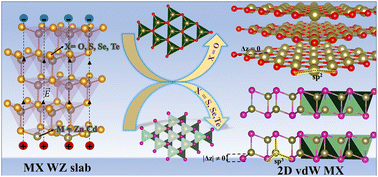First principles study on thickness dependent structural and electronic properties unveiling the growth and stability of 2D layered II–VI semiconducting compounds†
Abstract
By employing first principles density functional theory calculations on thickness dependent structural and electronic properties of (0001) surface slabs of wurtzite MX compounds, our study demonstrated the possibility of the existence of 2D layered materials from II–VI group traditional semiconducting compounds that are widely used in various fields. Our calculations revealed that (0001) surface slabs of wurtzite ZnO and CdO compounds prefer to stabilize as sp2 hybridized – atomically thin graphitic layers as observed in earlier work, which are separated by van der Waals distances, when compared to the respective wurtzite slabs. On the other hand, for surface slabs of other ZnX and CdX (X = S, Se, Te) compounds, sp3 hybridized bilayers, which comprise an X–Zn(Cd)–Zn(Cd)–X structural arrangement, are energetically stable until certain thicknesses of the slabs. Both 2D layered MO and MX systems are electronically insulating in nature. When increasing the number of layers in these systems, the band gap decreases due to the widening of the energy bands. Our calculations further confirmed that all of these 2D systems possess structural, elastic, and lattice dynamical stabilities, depicting their compatibility in optoelectronics and photovoltaic applications, as confirmed by their effective mass and mobility.



 Please wait while we load your content...
Please wait while we load your content...